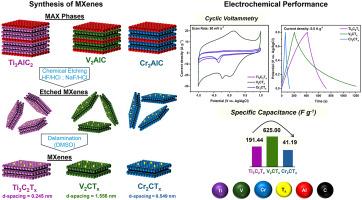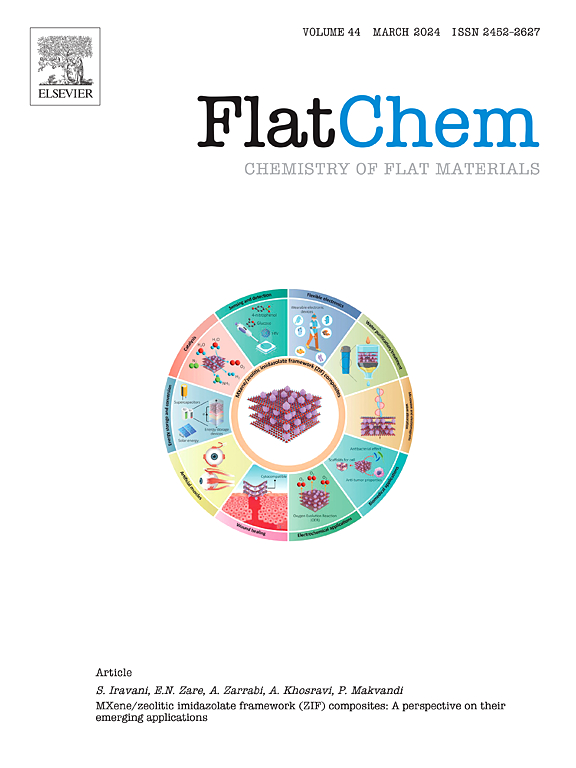Role of transition metal and etchant in the synthesis of MXenes (Ti-, V-, and Cr-) and their electrochemical properties as supercapacitor electrodes
IF 6.2
3区 材料科学
Q2 CHEMISTRY, PHYSICAL
引用次数: 0
Abstract
The effect of varying etchant on the synthesis of early 1st-row transition metal-based MXenes, including titanium (Ti), vanadium (V), and chromium (Cr), from their corresponding MAX phases were explored for supercapacitor applications. The MXenes were synthesised via chemical etching using HF/HCl or NaF/HCl mixtures, revealing that HF favors Ti-MXene while NaF is more effective for V- and Cr-MXenes. Comprehensive physiochemical characterisation including XRD, FTIR and XPS analyses confirmed the successful formation of transition metal carbides. FE-SEM/EDS and HR-TEM analyses revealed a two-dimensional layered morphology in each MXene with distinct lattice fringes, exhibiting d-spacing values of 0.245 nm, 1.556 nm, and 0.549 nm for Ti3C2Tx, V2CTx, and Cr2CTx respectively, confirming their crystalline nature. Furthermore, cyclic voltammetry revealed that V2CTx delivered the highest specific capacitance at 408.26 F g−1, compared to Ti3C2Tx (97.23 F g−1) and Cr2CTx (72.92 F g−1) at 2 mV s−1. Similarly, galvanostatic charge-discharge measurements showed a capacitance of 625.00 F g−1 for V2CTx, significantly outperforming Ti3C2Tx (191.44 F g−1) and Cr2CTx (41.19 F g−1) at 0.5 A g−1, while electrochemical impedance spectroscopy further confirmed its higher conductivity than the other MXenes. These findings underscore the critical role of the etchant in MXene synthesis and demonstrate the superior electrochemical performance of V-MXenes for supercapacitor electrodes.

过渡金属和蚀刻剂在MXenes (Ti-, V-和Cr-)合成中的作用及其作为超级电容器电极的电化学性能
研究了不同蚀刻剂对钛(Ti)、钒(V)和铬(Cr)等第一行过渡金属基MXenes的影响,探讨了其在超级电容器中的应用。用HF/HCl或NaF/HCl混合物进行化学刻蚀合成MXenes,发现HF有利于ti -MXenes, NaF对V-和Cr-MXenes更有效。包括XRD、FTIR和XPS分析在内的综合理化表征证实了过渡金属碳化物的成功形成。FE-SEM/EDS和HR-TEM分析显示,Ti3C2Tx、V2CTx和Cr2CTx的d-spacing分别为0.245 nm、1.556 nm和0.549 nm,各MXene均呈二维层状,具有明显的晶格条纹,证实了它们的结晶性质。此外,循环伏安法表明,在2mv s−1下,V2CTx的比电容最高,为408.26 F g−1,而Ti3C2Tx为97.23 F g−1,Cr2CTx为72.92 F g−1。同样,恒流充放电测量表明,V2CTx的电容为625.00 F g−1,显著优于Ti3C2Tx (191.44 F g−1)和Cr2CTx (41.19 F g−1),而电化学阻抗谱进一步证实了其电导率高于其他MXenes。这些发现强调了蚀刻剂在MXene合成中的关键作用,并证明了v -MXene用于超级电容器电极的优越电化学性能。
本文章由计算机程序翻译,如有差异,请以英文原文为准。
求助全文
约1分钟内获得全文
求助全文
来源期刊

FlatChem
Multiple-
CiteScore
8.40
自引率
6.50%
发文量
104
审稿时长
26 days
期刊介绍:
FlatChem - Chemistry of Flat Materials, a new voice in the community, publishes original and significant, cutting-edge research related to the chemistry of graphene and related 2D & layered materials. The overall aim of the journal is to combine the chemistry and applications of these materials, where the submission of communications, full papers, and concepts should contain chemistry in a materials context, which can be both experimental and/or theoretical. In addition to original research articles, FlatChem also offers reviews, minireviews, highlights and perspectives on the future of this research area with the scientific leaders in fields related to Flat Materials. Topics of interest include, but are not limited to, the following: -Design, synthesis, applications and investigation of graphene, graphene related materials and other 2D & layered materials (for example Silicene, Germanene, Phosphorene, MXenes, Boron nitride, Transition metal dichalcogenides) -Characterization of these materials using all forms of spectroscopy and microscopy techniques -Chemical modification or functionalization and dispersion of these materials, as well as interactions with other materials -Exploring the surface chemistry of these materials for applications in: Sensors or detectors in electrochemical/Lab on a Chip devices, Composite materials, Membranes, Environment technology, Catalysis for energy storage and conversion (for example fuel cells, supercapacitors, batteries, hydrogen storage), Biomedical technology (drug delivery, biosensing, bioimaging)
 求助内容:
求助内容: 应助结果提醒方式:
应助结果提醒方式:


